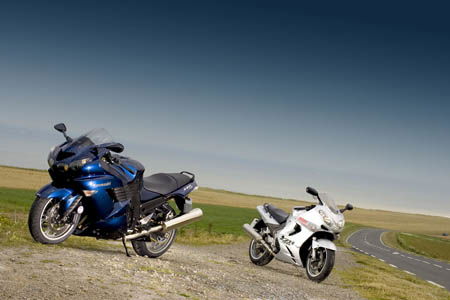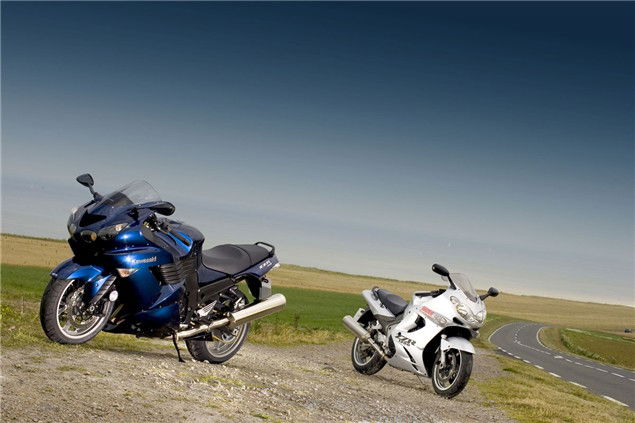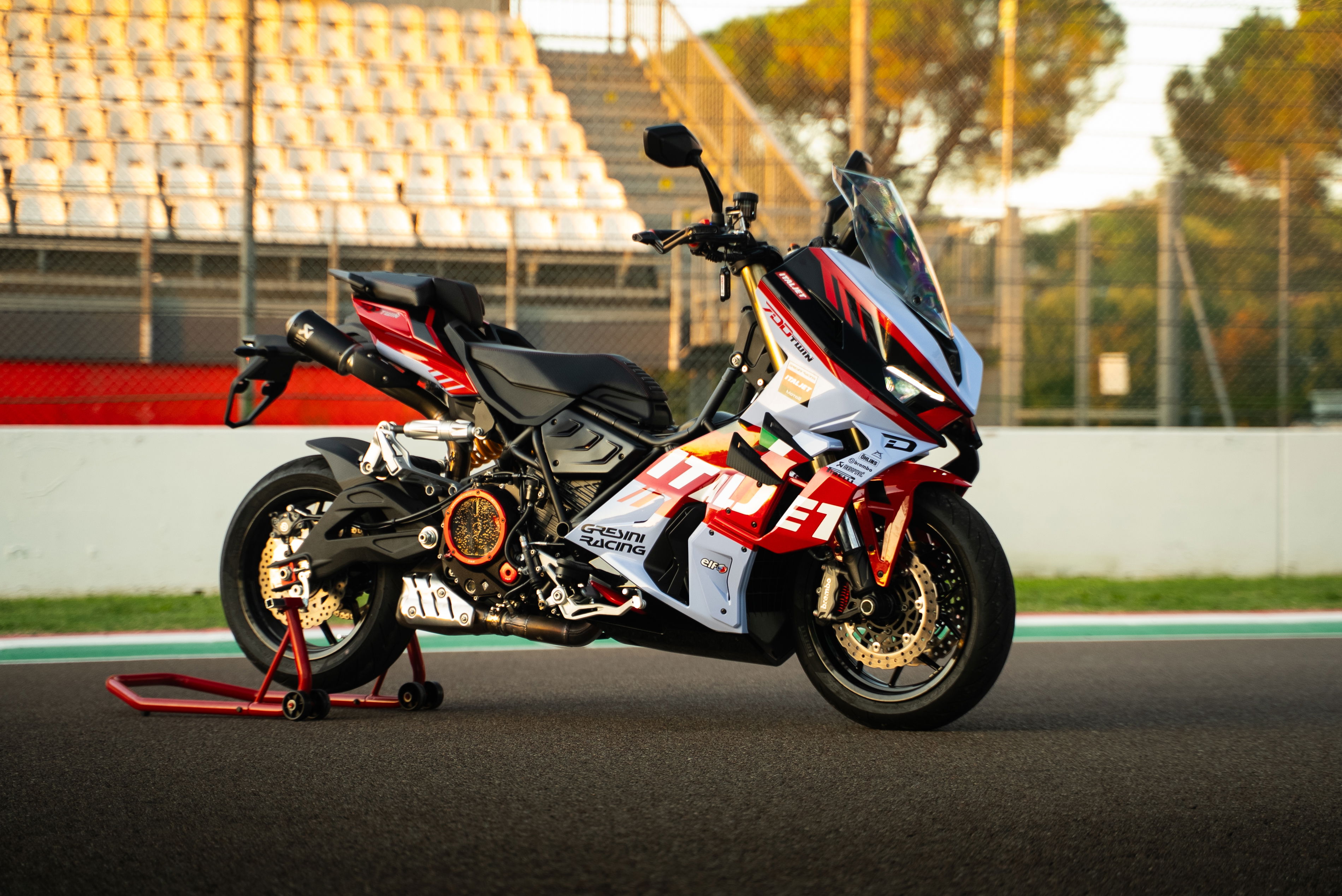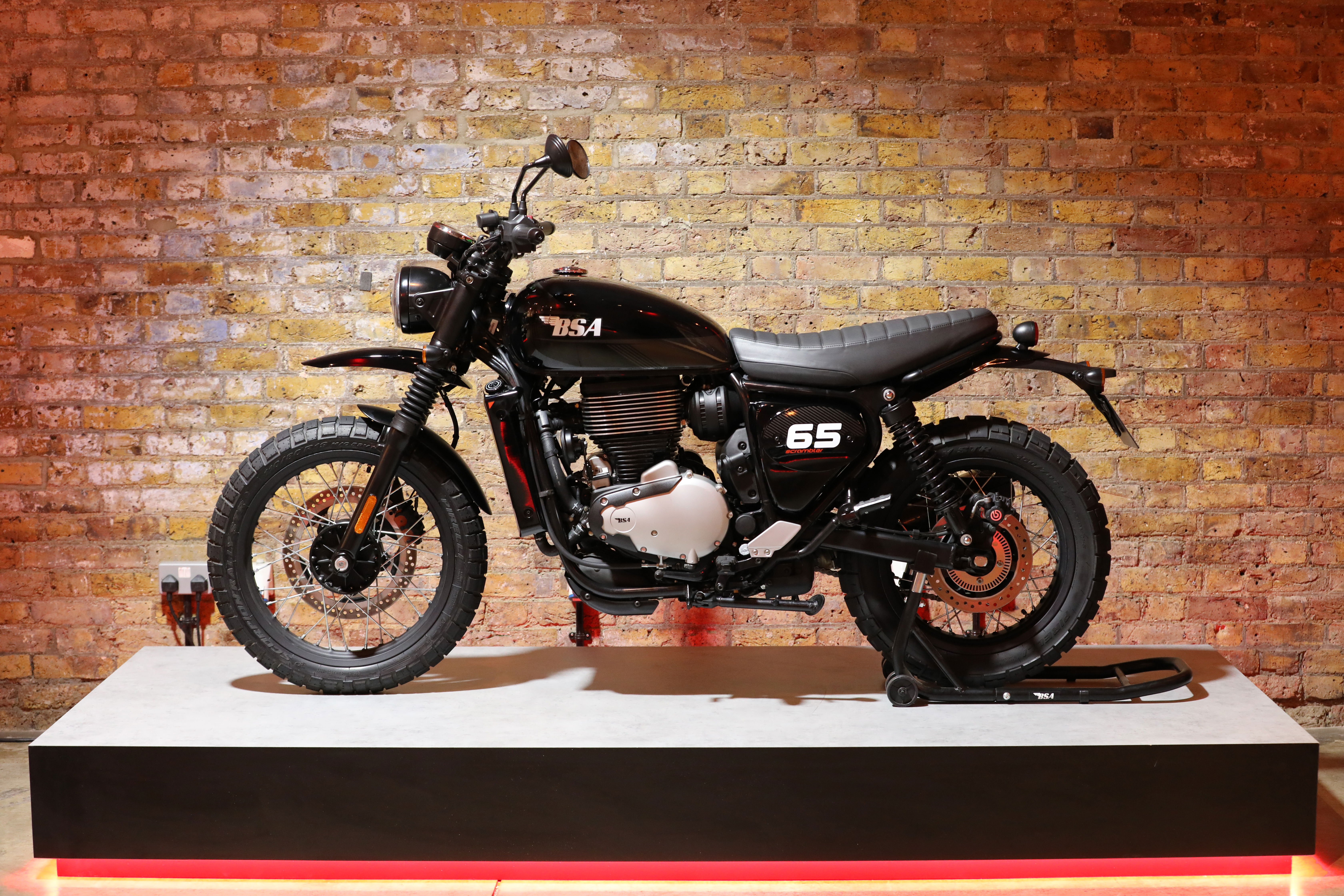Splitting Heirs: Kawasaki ZZ-R1200 v ZZR1400
As Splitting Heirs contests go, this would seem the most one-sided fight yet. Only it's not. Thought the ZZR1400 to be the ultimate speed king? Well, maybe you've never ridden a 2002 ZZR1200 then...


|
The latest ZZR1400 has rapidly achieved iconic status. Back in 1990 the ZZR1100 was able to stand proud as the fastest production motorcycle ever, with its genuine 168mph making it the quickest by a good margin. The ultimate muscle statement, it usurped GSX-Rs and the EXUP with flippant candour. Now that production motorcycles have been speed limited by manufacturer's agreement (not legislation), so the ZZR1400 has become instead the most powerful, nudging the 200bhp threshold in brochures around the country. Even if that translates to a more genuine 170bhp-ish at the back wheel...
We like it, with no end of superlatives and tales of jaw-dropping performance, and the British buying public love it too. The first year's shipment was sold out ahead of arrival, and even today new supplies are tight, making for strong residuals on second hand machines.
BUT HOW GOOD IS IT?
TWO pitched the ZZR1400 up against the Honda Blackbird, a contest convincingly won by the ZZR where it only lost out on solid motorway work, where the superior comfort and silky-smooth motor of the Honda won it a gong. So pitching the 14 up against its four year-old forebearer, the ZZR1200, should seem a foregone conclusion. And of course with the ZZR1200 being a sports tourer, not a super sports (the ZX-12R was Kawasaki's big-capacity super sports back then) the old bike's soft-focus should see it steam-rolled.
Only we'll give you a hint as to what's coming, right now. You see, the touring ZZR1200 of 2002 in fact had a powered-up motor, making in the order of 8% more power than the ZZR1100, and therefore making the 12 significantly more powerful than the Super Blackbird...
ENGINES
Kawasaki's engine lineage isn't what you would call entirely clear. What constitutes a new motor, and what's just a 'modified', is never made crystal. We can at least say for sure that the 1200 motor is a development of the 1100's. The extra displacement came by way of a change to alloy bores that allowed an extra 3mm diameter over the 1100's iron liners which together with an extra 1.6mm on the stroke created the 1,164cc capacity. The motor's claimed 160bhp (ram-air assisted) converted to a real world 145bhp on the dyno. In some ways then, the motor's old-school - after all its got carburettors - Keihin 40mm CVKs. Remember them? But there was new tech in there too - the K-TRIC throttle position sensor for optimised ignition timing and the KLEEN catalytic converter system.
The 1400 motor isn't listed as 'new' but with significantly bigger bore and stroke dimensions it's a full 188cc bigger than the ZZR1200. Now fuel injected, according to Kawasaki the new engine has been massively tuned, their figures putting the ZZR1400 as 25% more powerful than the ZZR1200. Yep, Kawasaki claim 200bhp with ram-air assistance, Only here's a thing: on Carbontek's dyno that 200 figure converted to 165.7bhp at the rear wheel - a figure which is barely 14% up on the ZZR1200's motor. Now that doesn't sound so earth shatteringly massive does it?
And if we'd known that when we came to do our side-by-side roll-on tests we wouldn't have been so shocked at the outcome. You see, there we were at 5.30am on the motorway to Dover, checking out 60 to 120mph top gear acceleration. And what happened? Dead heats. Actually not even that. Some the ZZR1200 won. The only difference was rider reaction time; whatever was won or lost was done on the initial twist of the wrist. We even tried the same roll-ons in fifth and fourth gears - and still no discernable differences. Holy cow! Can this be true? Well, we rang Kawasaki UK when we got back and told them. The response wasn't official, but they explained that the real power gains - as is the modern way - are really found in the higher realms of the rev range. So we probably wouldn't be finding the differences sub-120mph.
Not that the ZZR1400 is in any way underwhelming. It's still blindingly fast, and the way it accelerates from 150mph with a dollop of full throttle is quite indecent. But despite mind warping acceleration, you may care to down-shift a gear before trying to waste the odd old-school rocket ship. On the motorway the ZZR1400 wasn't scoring the points it should, and the ZZR1200 was easily its match. Those old carbs made for smooth pick-up, less snatchy for sure, and it felt altogether very relaxed. It was probably the tall screen (fitted as standard) that helped create a very laid back atmosphere - quick checks of the speedo frequently revealed far faster velocities than anticipated.
But put these two on some twisting roads, and some really twisting, well contoured ones at that, and you'll find the ZZR1400 steams away. Only now we're not convinced that's entirely due to the motor, however strong it is, for often the technique to fast progress with the 1400 was to short shift and let the motor torque.
The ZZR1400 motor also struggled, curiously, when ridden sort of 'furiously' for the photoshoot. When turning in the road for repeated passes past the photographer the ZZR1400 would fluff badly off the bottom, requiring clutch slip and a good handful to get it going. By contrast you could U-turn the ZZR1200 and then, with a deft dip of the clutch, launch the old 'un up the road with a satisfyingly large and lusty wheely. Trying to wheelie the 1400 in these circumstances was best avoided, the throttle's response being quite unpredictable.You can thank the Euro 3 regulations for some of that.
CHASSIS
The 1200's chassis is directly related to that of the original ZX-10 of 1986. Some 16 years after Kawasaki's original dual beam framed thou', the 2002 ZZR still featured an almost identical design. The suspension though was a disappointment. The forks are 43mm conventional Kayabas with preload adjustment only, while the shock features basic preload and rebound adjustment. When tested back in 2002 the ZZR1200 proved quite adept. The feel was akin to a super-sized CBR600, but riding this five-year-old example showed that while the ZZR motor can take some 35,000 miles of abuse and stunningly still match a box-fresh 1400 for performance, the same cannot be said of its handling.
The high mileage on the suspension had reduced its abilities significantly. Despite near-new Continental tyres, the lack of real damping in either the forks or shock made for imprecise progress. Soft and cushy for motorway work (nice), the suspension was entirely overcome by fast twisty road riding. You could hustle it along, but for each corner you'd want to settle it in first, like an old man tucking in his pyjamas.
Oddly enough the brakes had survived well. On first encounter they were wooden and uninspiring, but repeated hard braking seemed to do the pads a world of good, the feel kept improving while the Tokico four-pots were doing well, given the mass.
The 1400 is, without a doubt, altogether a more dynamic and thrilling package. The chassis, an aluminium monocoque, is a development of that used in the ZX-12R but is massively better than that. Kawasaki claim the monocoque is inherently more rigid than a twin-spar frame, and the ZZR1400 feels low and intuitive. Weight is of course down - a claimed 215kg (dry) as against the ZZR1200's 236kg. And the geometry is sharper again, 23û compared to 25¡. Significantly the suspension is now of a super sports specification. The 43mm Kayabas are now inverted with compression and rebound damping adjustment and the same goes for the shock. Running on lighter wheels (we can't confirm how much lighter) with the latest 310mm petal discs and radial four-piston brakes, the ZZR1400 feels supremely confident at speed, even on the twistiest roads.
We repeated two sections of road. The first featured a blind crest taken charging in the middle part of third gear, which was followed by a steep downhill and hairpin turn. Here it was a challenge to freak yourself out by attacking the crest as hard as you dare - a crest taken with some lean on. Yet the 14 never budged from its line. Easy. It was only the hairpin which challenged the 1400. Here the suspension took too long to settle and it took positive throttle to hold it all together. Some time with the adjusters would have helped. The other section of road, a stunning third gear drive up a sweeping uphill left leading into a second gear right again showed how far the ZZR has come. The 1200 should have been able to keep up, but its handling just fell apart. The ZZR1400 simply goaded you on to ride harder and harder.
LOOKS-WISE
The ZZR1200 won't ever be a classic. It took the remarkably restrained yet powerful curves and flanks of the ZZR1100 and added a set of Ford Mondeo lights circa 1997. Big blobby headlights and taillights do not an attractive roadbike make. Of course they may be supremely effective in use, but that's not what we're discussing here. The ZZR had always been mega-comfy, and now it was made to look it. No longer pegged as a GSX-R-killer as it earlier had, it was now fighting BMW K1200STs and Triumph Sprint STs.
The ZZR1400 looks bloody great. Big and brutal with some really classy touches, it's properly slippery while also working that Big Bike look to perfection. It's long, it looks long and of course, it looks sporty again. The wheels have that racy look, as do the brakes. The screen's lower and Lamborghini vents (last seen on 1995's Honda VFR750) are back with a vengeance.
JOHN HOGAN'S SECOND OPINION
Any bike with the letters ZZR on the side, even the diddy 600, has gained a reputation for being a thrustworthy way of getting around. I have spent more time on the 14 than any of the others and hadn't ridden a 12 until this test. Categorising the 12 is easy if you look purely at the dynamics. It is podgy, fairly soft and gets a bit ragged if things get silly on the road. But is that what this bike was designed for? Not really. When it came to things that we thought the 14 would walk, the 12 dug its pig ugly heels in and fought back like George Foreman the second time round. The motor on the 12, (considering it had done 35k) is stonking. I could more than put up with turning a fuel tap on and off if it meant I could have a set of carbs rather than the slightly fluffy EFI that the 14 had. The handling felt planted but in an 'overweight take it steady' kind of way, rather than the balanced poise that the 14 has thanks to the use of quality adjustable suspension and brakes. Once into a bend the 12 felt okay, but getting it there and, more importantly, trying to drive it out was nowhere near as easy or satisfying as on the 14. The versatility of the new bike shows how things have moved on since the launch of the 12, it can handle pretty much anything you throw at it whereas the 12 still does the straight-line fast bit no worries. Anything else and you've got to be a brave man and have faith in the tyres as the old girl wobbles and lurches.
CONCLUSION
The ZZR1400 arrived last year in the right place at the right time. Hyper sports bikes had gone stale. Much loved by British bikers, the lack of development by Honda in their Super Blackbird and Suzuki in their Hayabusa left the door open to a very excited response to a new 'biggest, fastest'. The hype and the styling exercise sealed the deal and ZZR1400s have been a sell-out success. Whether Suzuki's new Hayabusa will blunt the ZZR1400s sales remains to be seen, although the surprisingly un-radical re-launch of the Suzuki may well not damage the ZZR as first assumed. And the question hangs as to whether Honda will ever make a new Blackbird worthy of the challenge.
Regardless, the 1400 marks a return of the ZZR to the mantle it was originally designed for - super sports. Steering the ZZR1200 into touring, to allow the ZX-12R to take over at the pointy end was a slight on the ZZR's reputation. Even now, reading the performance figures and our roll-on tests, we can't believe how strong the old bike went. The chassis was hopelessly outgunned by the new bike, though. But with Kawasaki now putting the ZZR back on the top shelf and creating the GTR to match the new spec demanded for touring types, equilibrium in the Kawaski sporting line up is restored.
When a five-year-old bike can accelerate alongside the most powerful sports bike ever, it's impossible not to be impressed, but time is a hard master and the great chassis on the ZZR1400, not to mention sharp looks, made the new bike untouchable.
SPECS - ZZR1400
TYPE - SPORTS TOURER
PRODUCTION DATE - 2007
PRICE NEW - £8995 (NEW)
ENGINE CAPACITY - 1352cc
POWER - 171.1bhp@9600rpm
TORQUE - N/A
WEIGHT - 215kg
SEAT HEIGHT - 800mm
FUEL CAPACITY - 22L
TOP SPEED - 186mph
0-60 - n/a
TANK RANGE - N/A
SPECS ZZR1200
TYPE - SPORTS TOURER
PRODUCTION DATE - 2002
PRICE NEW - £3900 (USED)
ENGINE CAPACITY - 1164cc
POWER - 160bhp@9800rpm
TORQUE - N/A
WEIGHT - 236kg
SEAT HEIGHT - 800mm
FUEL CAPACITY - 23L
TOP SPEED - 168mph
0-60 - n/a
TANK RANGE - N/A

The latest ZZR1400 has rapidly achieved iconic status. Back in 1990 the ZZR1100 was able to stand proud as the fastest production motorcycle ever, with its genuine 168mph making it the quickest by a good margin. The ultimate muscle statement, it usurped GSX-Rs and the EXUP with flippant candour. Now that production motorcycles have been speed limited by manufacturer's agreement (not legislation), so the ZZR1400 has become instead the most powerful, nudging the 200bhp threshold in brochures around the country. Even if that translates to a more genuine 170bhp-ish at the back wheel...
We like it, with no end of superlatives and tales of jaw-dropping performance, and the British buying public love it too. The first year's shipment was sold out ahead of arrival, and even today new supplies are tight, making for strong residuals on second hand machines.
BUT HOW GOOD IS IT?
We pitched the ZZR1400 up against the Honda Blackbird, a contest convincingly won by the ZZR where it only lost out on solid motorway work, where the superior comfort and silky-smooth motor of the Honda won it a gong. So pitching the 14 up against its four year-old forebearer, the ZZR1200, should seem a foregone conclusion. And of course with the ZZR1200 being a sports tourer, not a super sports (the ZX-12R was Kawasaki's big-capacity super sports back then) the old bike's soft-focus should see it steam-rolled.
Only we'll give you a hint as to what's coming, right now. You see, the touring ZZR1200 of 2002 in fact had a powered-up motor, making in the order of 8% more power than the ZZR1100, and therefore making the 12 significantly more powerful than the Super Blackbird...











